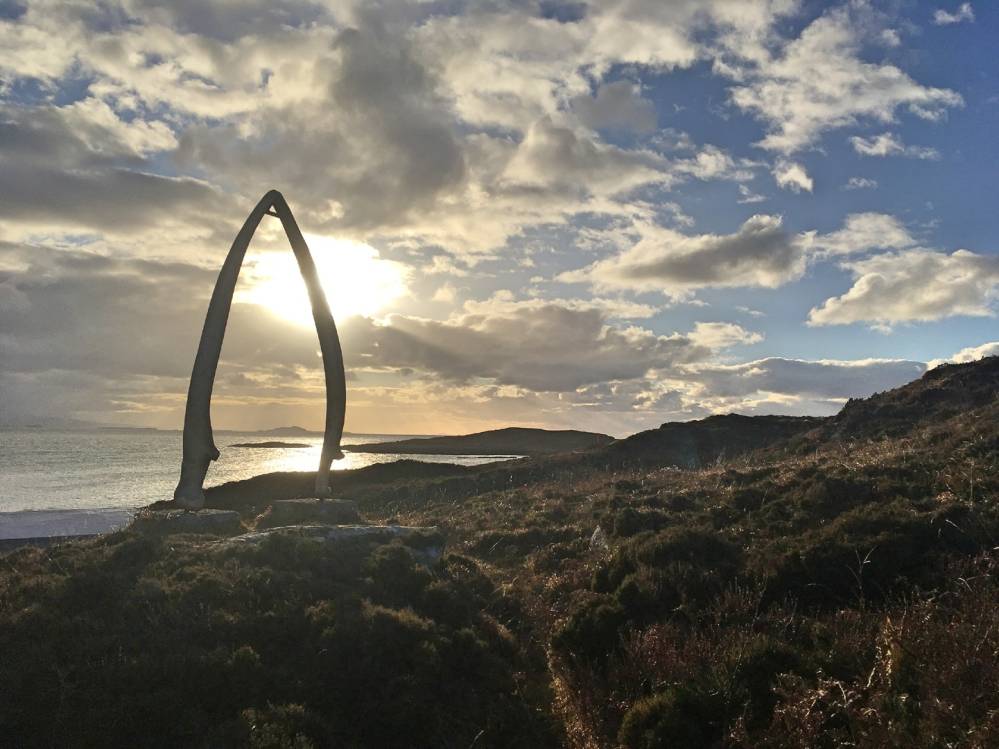Collette the Fin whale
Hebridean Whale & Dolphin Trust
Collette the Fin whale
In early February of 2004 a rare female Fin whale carcass washed ashore Feall Beach in the south west end of the island causing a stir of creative thinking amongst the islanders. The National Museum of Scotland sent a team to collect the carcass and take it back to Edinburgh although some islanders, after hearing of the retrieval operation, had other plans. They wanted to keep and erect the whale’s 12ft jawbones as a traditional arch in front of the local church as a backdrop for weddings, christenings etc.
‘Collette’s’ jaw bones became Coll’s equivalent to the Stone of Destiny. 25 days after the whale washed up, just the day before the museum people arrived, a group of intrepid islanders organised a covert raid to remove the jawbones using a chainsaw, handsaws, kitchen and butcher’s knives. A young farmer was called to help with his tractor and trailer, they were then hauled off in the dead of night to hide at the other end of the island and buried in the sand dunes.
The whale became the main topic of conversation in the local pub. Those who had seen it said it was AWESOME – it was paced out at 15 or 16 metres long... There was a lot of local interest, although, being in good condition and following shoreline protocol, it was designated Crown property and gifted to the National Museum of Scotland who were interested in the skeleton.
The museum research staff and local authority council workers arrived to transport the skeleton, bit by bit, to the research unit in Edinburgh, but, when they came to move the last pieces, they found the jawbones had disappeared! As the 56ft, 25 tonne Fin whale was in good condition, the museum was keen to preserve the complete skeleton. Over a month after being washed up on Feall Beach, the whale bones sailed away on the ferry.
The museum made an appeal to the media for the bones to be returned and the national newspapers were falling over themselves to find out who had hidden the jaw bones of what Collachs were calling ‘their’ whale. When the story appeared on the national news, the bones were moved again, this time into the village, as too many people had known where they had been hidden initially. The young farmer was quoted in the paper saying: “I was going to bury them again but then the special constable told me I had to give them back. It was a shock when it started getting so serious that it was on the television news.” No crime was reported.
Eventually, after much negotiation, the jawbones were given to the museum in exchange for a fibreglass model, cast from the jawbones, which was delivered back to the island where they are now situated above the new pier for all to enjoy. A museum spokesperson said “We’re delighted that the jawbones have been found and are looking forward to reuniting Collette with her chin. We don’t have a complete Fin whale skeleton, so finding these jawbones helps fill a massive gap in our collection”.
Thanks go to the Scottish Daily Mirror and NatureScot for covering the costs of casting the jawbones and producing the fibre glass model. There was even a short documentary film made by Ewan MacNicol in 2004 about the story, Bones of Contention, which unearths the mysteries of the missing bones and the islanders misgiving about ‘their’ whale.
As told by a 'Collach' (a person from Coll)
More information on visiting the area can be found here.
